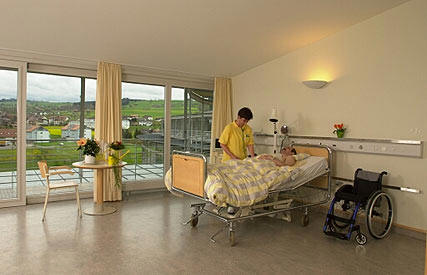

Gurimur® Wallcoverings in the Swiss Paraplegics Centre
(Auszug aus dem DuPont-Magazin 4/2000)
| Apart from being a hospital, the Swiss Paraplegics Centre is a national sports centre, with a 400-metre track for wheelchair races and other sports facilities. |  |
Beat Bösch broke his back in a trampoline accident when he was 24. Thanks to the caring skills of the staff at the Swiss Paraplegics Centre (SPC) at Nottwil, near Lucerne, he not only survived: after spinal surgery, intense medical care and several months' physiotherapy and rehabilitaion, he now leads an active life again. He earns his living, drives a car and is a successful sportsman. The only difference is that he is in a wheelchair.
Opened in 1990, and enlarged eight years later, the SPC combines many functions. It is a fully-fledged hospital with three operating theatres; it is a rehabilitation clinic;it is a national sports centre designed for paraplegics, with a 400-metre track for wheelchair races, a 45x30-metre gymnasium, a 25-metre swimming pool, saunas and massage rooms; and it has a conference hall and social centre. Today, the SPC has 140 beds for patients and employs nearly 700 staff. The establishment enjoys worldwide renown, as much the standard and completeness of its services as for its equipment and overall design.
The situation for paraplegics in Switzerland has improved immensely since 1975, thanks to the efforts of Dr. Guido A. Zäch, head of the SPC. In 1975, he set up the Swiss Paraplegics Foundation to back his concept of holistic care for paraplegics, to be carried out in a special clinic. Rehabilitation of paraplegics includes not only surgery, medical care and physiotherapy, but also everything that it takes to reintegrate them into their families, into a suitable occupational activity and into society. Fulfilling this concept, paraplegics are helped with such things as having stair-lifts installed in their homes, adjusting working surfaces to "wheelchair level" and supplying cars for paraplegic drivers.
The three organisations - the Swiss Paraplegics Foundation, the Swiss Paraplegics Centre, and the Swiss Paraplegics Association - have together enabled more than 6000 paraplegics like Beat Bösch, as well as numerous tetraplegics, who have lost feeling in, and control of, their arms as well as their legs, to resume a near-normal existence. About 80 per cent of paraplegics in Switzerland take up a money-earning occupational activity again after their stay at the SPC. Paraplegics have also chalked up many successes of different kinds: for example, a paraplegic woman has given birth to healthy twins; a paraplegic man in a wheelchair has completed a fulllength 42,2 kilometre marathon race in 80 minutes.
"We needed a robust material"
Ernst Schürch, now the SPC's director of technical services, was a member of the building commitee when planning for the Centre started in 1988. At that time, the question arose as to what wall-covering would be best suited for a building fulfilling so many functions. "It had to be a robust material that would remain like new for many years; it had to be gygienic and easy to keep clean, and had to withstand disinfectants and other chemicals as well as common solvents. If repairs were needed, fresh material would have to be available without colour-matching or pattern-matching problems, "Schürch recalls today.
| An interior view of the Swiss Paraplegics Centre. The wall covering is Gurimur® with a surface of DuPont Tedlar® PVF-film. |
 |
After reviewing varios materials, the commitee decided on Gurimur®, a wall-covering with a surface of DuPont Tedlar® PVF, or polyvinyl fluoride, film. Tedlar® is chemically related to another DuPont product, Teflon®, known for its almost universal chemical resistance and for the fact that nothing will stick to it. In this particular wall-covering, a layer of Tedlar is laminated onto a backing of cotton fabric which can be directly adhered to a suitably prepared wall surface.
The Gurimur® TEDLAR® wallcovering is colour-fast, moisture-resistant and withstands temperatures up to 100°C. As it is extensible, it easily covers fissures in a wall substrate. It is washable and unaffected by chemicals. It is difficult to ignite, is non-irritant to the skin and is a tough material, so that it withstands scuffing and abrasion.
In the SPC complex of buildings, Gurimur® TEDLAR® and Gurimur® S are applied to almost all the internal walls. "the properties of a wall-covering like this are obviously needed in such places as operating theatres, where blood may splash onto walls and hygiene is of paramount importance," Schürch notes. "However it is also in all the examination rooms, in the corridors, in the patients' rooms, and elsewhere.
"Up to 10 months in the Centre"
The patients may spend a long time in the Paraplegics Centre, and sometimes as long as ten months in the most difficult cases. To make the space around their beds look as friendly and cheerful as possible, they usually affix photographs, postcards, pictures, letters or similar items to the wall. "For this reason we have built a thin metal plate into the walls, immediately under the Gurimur® layer, so that the patients can mount these objects with magnetic clips which do not damage the surface," explains Schürch. "In practice, when a patient leaves us after some months, there are nound to be some dirty marks on the wall. The a Gurimur® covering is easy to wash clean; and even if the patients should use nails or pins to fix their decorations and get-well wishes on the wall, damage remains negligible," he says.
In 1996, the time came again to plan an expansion to the first-phase buildings. "We then reviewed our material choices of eight years earlier," says Schürch, "and found that the original 4000 square metres of Gurimur® had given good service. We ordered a further 4500 square metres, which were applied to almost all the walls in the second-phase sections opened in 1998. It was good value for money.
Gurimur® surfaced with Tedlar® is the ideal wall-covering for medical and para-medical establishments of all kinds.